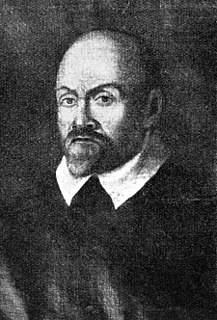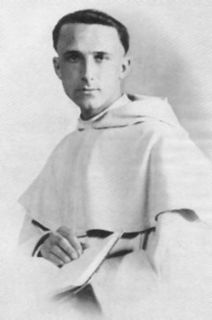Related Research Articles

Giovanni Botero was an Italian thinker, priest, poet, and diplomat, author of Della ragion di Stato , in ten chapters, printed in Venice in 1589, and of Universal Relations,, addressing the world geography and ethnography. With his emphasis that the wealth of cities was caused by adding value to raw materials, Botero may be considered the ancestor of both Mercantilism and Cameralism.

The Pontifical University of Saint Thomas Aquinas (PUST), also known as the Angelicum in honor of its patron the Doctor Angelicus Thomas Aquinas, is a pontifical university located in the historic center of Rome, Italy. The Angelicum is administered by the Dominican Order and is the order's central locus of Thomist theology and philosophy.

Réginald Marie Garrigou-Lagrange was a French Catholic theologian and Dominican friar. He has been noted as a leading neo-Thomist of the 20th century, along with Jacobus Ramírez, Édouard Hugon, and Martin Grabmann. He taught at the Dominican Pontifical University of St. Thomas Aquinas, the Angelicum, in Rome from 1909 to 1960. There he wrote his magnum opus, The Three Ages of the Interior Life in 1938.

Sixtus of Siena (1520–1569) was a Jew who converted to Roman Catholicism, and became a Roman Catholic theologian.
Dominic Gravina was an Italian Dominican theologian.
Vincenzo della Greca was an Italian architect.
Annibale Annibaldi, also known as Annibaldo degli Annibaldi, was an Italian Catholic theologian,
Giovanni Faber (1574–1629) was a German papal doctor, botanist and art collector, originally from Bamberg in Bavaria, who lived in Rome from 1598. He was curator of the Vatican botanical garden, a member and the secretary of the Accademia dei Lincei. He acted throughout his career as a political broker between Maximilian I, Elector of Bavaria and Rome. He was a friend of fellow Linceian Galileo Galilei and the German painters in Rome, Johann Rottenhammer and Adam Elsheimer. He has also been credited with inventing the name "microscope".

Margherita Gonzaga was Duchess of Lorraine from 1606 until 1624 by marriage to Henry II, Duke of Lorraine. She was an agent of Pro-French and anti Protestant policy in Lorraine, and are most known for her support of her daughter Nicole's right to the Duchy of Lorraine. She also claimed her right to Monferrato during the Mantuan war of succession.

Vincenzo Cartari was a mythographer, secretary, and diplomat of the Italian Renaissance, studied by Jean Seznec and scholars of the Warburg Institute.

Fulvio Testi was an Italian diplomat and poet who is recognised as one of the main exponents of 17th-century Italian Baroque literature. He worked in the service of the d'Este dukes in Modena, for whom he held high office, such as the governorship of Garfagnana. His poems tackle civic themes in solemn tones, showing Testi's lasting anti-Spanish and, consequently, pro-Savoia political passions. Accused of treason for having tried to set up diplomatic relations with the French court, he was imprisoned and died in jail soon after. One later literary critic wrote:
If he'd been born in a less barbarous age, and had had more time than he did to cultivate his talent, he would doubtless have been our Horace, and perhaps been hotter and more vehement and more sublime than the Latin man
Giovanni Battista de Marinis was the Master of the Order of Preachers from 1650 to 1669.
Mariano da Alcamo was an Italian Catholic presbyter.
Pietro Bongo was a renaissance Italian writer.
Camillo Caetani (Gaetano) was an Italian aristocrat and Papal diplomat in several European capitals during the early Counterreformation.
Biagio Cusano was an Italian Marinist poet and professor of law. The date of his birth is currently unknown. He is best known for being Gennaro Cusano's uncle and Marcello Papiniano Cusani's grand uncle.
Stefano Fabri junior was the son of Stefano Fab(b)ri (1560–1609), who was the Kapellmeister of the Cappella Giulia. He was the pupil of Giovanni Bernardino Nanino. He was the music teacher of Francesco Beretta.

Vittorio Cini, Count of Monselice was an Italian industrialist and politician, Senator from 1934 to 1943 and Minister of Communications of the Kingdom of Italy from February to July 1943. He was among the richest people in Italy in his time.

Margherita Sarrocchi was an Italian poetess and a supporter of the theories of Galileo. She was first friend and lover, then rival and enemy of Giambattista Marino, and wrote an epic poem in twenty-three cantos, the Scanderbeide, celebrating the heroic exploits of Scanderbeg against the Ottoman Turks.
References
- ↑ Sosio Pezzella, "Candido, Vincenzo", Dizionario Biografico degli Italiani , vol. 17 (1974).
- ↑ "CANDIDO, Vincenzo in "Dizionario Biografico"".
- ↑ Monumenta et antiquitates veteris disciplinae Ordinis Praedicatorum ab anno 1216 ad 1348 vol. II, 1864, 140. https://books.google.com/books?id=bM6wwPZorcAC&pg=PA140#v=onepage&q&f=false Accessed June 20, 2011; See also http://www.treccani.it/enciclopedia/vincenzo-candido_(Dizionario-Biografico)/ Accessed June 22, 2011
- ↑ http://www.treccani.it/enciclopedia/vincenzo-candido/ Accessed 22 March 2013; Bibliotheca sicula, sive de scriptoribus siculis, qui tum vetera, tum ... By Antonino Mongitore, 279a https://books.google.com/books?id=YQY_AAAAcAAJ&pg=PA279#v=onepage&q&f=false Accessed 22 March 2013